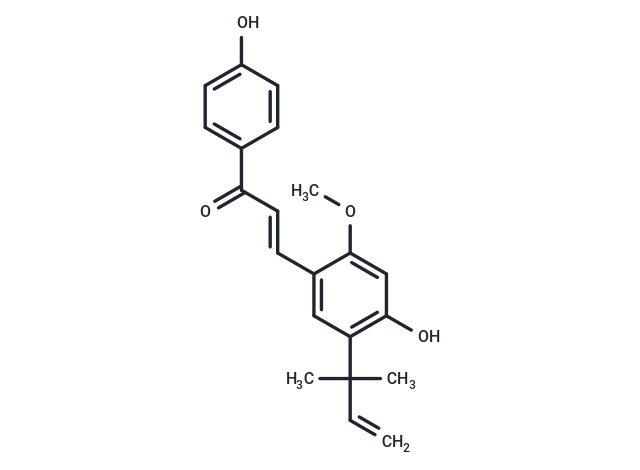Shopping Cart
- Remove All
 Your shopping cart is currently empty
Your shopping cart is currently empty

Licochalcone A is a flavonoid isolated from the famous Chinese medicinal herb Glycyrrhiza uralensis Fisch with obvious anti-cancer effects.

| Pack Size | Price | Availability | Quantity |
|---|---|---|---|
| 20 mg | $100 | In Stock | |
| 1 mL x 10 mM (in DMSO) | $50 | In Stock |
| Description | Licochalcone A is a flavonoid isolated from the famous Chinese medicinal herb Glycyrrhiza uralensis Fisch with obvious anti-cancer effects. |
| Targets&IC50 | UGT1A1:0.97 μM |
| In vitro | Licochalcone A markedly inhibits the in vitro growth of L. major amastigotes in human MDMs and U937 cells. [1] Licochalcone A shows antibacterial effects against all gram-positive bacteria tested and especially against all Bacillus spp. Tested with MICs of 2 to 3 micrograms/mL. [3] In CT-26 colon cancer cells, Licochalcone A reduces the cell viability and DNA synthesis. [4] Licochalcone A also interferes with MAPK signaling cascades, initiates ROS generation, induces oxidative stress and consequently causes BGC cell apoptosis. [5] |
| In vivo | In mice infected with L. major, licochalcone A (5 mg/kg, i.p.) completely prevents lesion development. In mice infected with L. donovani, licochalcone A (150 mg/kg, p.o.) results in > 65 and 85% reductions of parasite loads in the liver and the spleen, respectively. [2] In CT-26 cell-inoculated Balb/c mice, licochalcone A (1 mg/kg, p.o.) inhibits the tumor growth, and alleviates cisplatin-induced nephrotoxicity and hepatotoxicity. [4] |
| Cell Research | The viability of CT-26 mouse colon cancer cells is determined via a MTT assay. In brief, colon cancer cells are seeded onto each well of a 96-well plate with DMEM containing 10% FBS and cultured to adhere overnight. The cells are then treated with various concentrations of LCA in serum-free medium for 24 and 72 hr, respectively. Twenty microlitres of a MTT solution (5 mg/ml) is added to each well, and the cells are incubated for 4 hr at 37°. The medium is then removed, and 200 μL of dimethyl sulfoxide is added to each well. The absorbance is determined at 570 nm using a microplate reader.(Only for Reference) |
| Molecular Weight | 338.4 |
| Formula | C21H22O4 |
| Cas No. | 58749-22-7 |
| Smiles | COc1cc(O)c(cc1\C=C\C(=O)c1ccc(O)cc1)C(C)(C)C=C |
| Relative Density. | 1.171 g/cm3 (Predicted) |
| Storage | Powder: -20°C for 3 years | In solvent: -80°C for 1 year | Shipping with blue ice. | |||||||||||||||||||||||||||||||||||
| Solubility Information | Chloroform: Soluble H2O: < 1 mg/mL (insoluble or slightly soluble) DMSO: 55 mg/mL (162.53 mM), Sonication is recommended. Ethanol: 67 mg/mL (197.99 mM), Sonication is recommended. | |||||||||||||||||||||||||||||||||||
| In Vivo Formulation | 15% Cremophor EL: 5 mg/mL (14.78 mM), Solution. Please add the solvents sequentially, clarifying the solution as much as possible before adding the next one. Dissolve by heating and/or sonication if necessary. Working solution is recommended to be prepared and used immediately. The formulation provided above is for reference purposes only. In vivo formulations may vary and should be modified based on specific experimental conditions. | |||||||||||||||||||||||||||||||||||
Solution Preparation Table | ||||||||||||||||||||||||||||||||||||
DMSO/Ethanol
| ||||||||||||||||||||||||||||||||||||

Copyright © 2015-2025 TargetMol Chemicals Inc. All Rights Reserved.